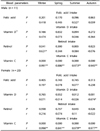2. Woodhouse PR, Khaw KT, Plummer M, Foley A, Meade TW. Seasonal variations of plasma fibrinogen and factor VII activity in the elderly: winter infections and death from cardiovascular disease. Lancet. 1994; 343:435–439.

3. Capita R, Alonso-Calleja C. Differences in reported winter and summer dietary intakes in young adults in Spain. Int J Food Sci Nutr. 2005; 56:431–443.

4. Xiang J, Nagaya T, Huang XE, Kuriki K, Imaeda N, Tokudome Y, Sato J, Fujiwara N, Maki S, Tokudome S. Sex and seasonal variations of plasma retinol, alpha-tocopherol, and carotenoid concentrations in Japanese dietitians. Asian Pac J Cancer Prev. 2008; 9:413–416.
5. Shahar DR, Froom P, Harari G, Yerushalmi N, Lubin F, Kristal-Boneh E. Changes in dietary intake account for seasonal changes in cardiovascular disease risk factors. Eur J Clin Nutr. 1999; 53:395–400.

6. Moreira PL, Villas Boas PJ, Ferreira AL. Association between oxidative stress and nutritional status in the elderly. Rev Assoc Med Bras (1992). 2014; 60:75–83.

7. Hacettepe University (TR). The Dietary Guidelines of Turkey. Ankara: Hacettepe University;2015. 07.
8. Talwar D, Ha TK, Cooney J, Brownlee C, O'Reilly DS. A routine method for the simultaneous measurement of retinol, alpha-tocopherol and five carotenoids in human plasma by reverse phase HPLC. Clin Chim Acta. 1998; 270:85–100.

9. Brunetto MR, Obando MA, Gallignani M, Alarcón OM, Nieto E, Salinas R, Burguera JL, Burguera M. HPLC determination of Vitamin D
3 and its metabolite in human plasma with on-line sample cleanup. Talanta. 2004; 64:1364–1370.

10. Wang S, Schram IM, Sund RB. Determination of plasma ascorbic acid by HPLC: method and stability studies. Eur J Pharm Sci. 1995; 3:231–239.

11. Quinlivan EP, Hanson AD, Gregory JF. The analysis of folate and its metabolic precursors in biological samples. Anal Biochem. 2006; 348:163–184.

12. van Ooijen AM, van Marken Lichtenbelt WD, van Steenhoven AA, Westerterp KR. Seasonal changes in metabolic and temperature responses to cold air in humans. Physiol Behav. 2004; 82:545–553.

13. Penckofer S, Kouba J, Byrn M, Estwing Ferrans C. Vitamin D and depression: where is all the sunshine? Issues Ment Health Nurs. 2010; 31:385–393.

14. O'Connor DB, O'Connor RC. Perceived changes in food intake in response to stress: the role of conscientiousness. Stress Health. 2004; 20:279–291.
15. Michels N, Sioen I, Ruige J, De Henauw S. Children's psychosocial stress and emotional eating: a role for leptin? Int J Eat Disord. 2017; 50:471–480.

16. Frankenfeld CL, Lampe JW, Shannon J, Gao DL, Li W, Ray RM, Chen C, King IB, Thomas DB. Fruit and vegetable intakes in relation to plasma nutrient concentrations in women in Shanghai, China. Public Health Nutr. 2012; 15:167–175.

17. Cai H, Shu XO, Hebert JR, Jin F, Yang G, Liu DK, Gao YT, Zheng W. Variation in nutrient intakes among women in Shanghai, China. Eur J Clin Nutr. 2004; 58:1604–1611.

18. Smolková B, Dusinská M, Raslová K, McNeill G, Spustová V, Blazícek P, Horská A, Collins A. Seasonal changes in markers of oxidative damage to lipids and DNA; correlations with seasonal variation in diet. Mutat Res. 2004; 551:135–144.

19. Volkert D, Kreuel K, Heseker H, Stehle P. Energy and nutrient intake of young-old, old-old and very-old elderly in Germany. Eur J Clin Nutr. 2004; 58:1190–1200.

20. Gilbride JA, Amella EJ, Breines EB, Mariano C, Mezey M. Nutrition and health status assessment of community-residing elderly in New York City: a pilot study. J Am Diet Assoc. 1998; 98:554–558.

21. Olmedilla B, Granado F, Blanco I, Rojas-Hidalgo E. Seasonal and sex-related variations in six serum carotenoids, retinol, and alpha-tocopherol. Am J Clin Nutr. 1994; 60:106–110.

22. Rautalahti M, Albanes D, Haukka J, Roos E, Gref CG, Virtamo J. Seasonal variation of serum concentrations of beta-carotene and alpha-tocopherol. Am J Clin Nutr. 1993; 57:551–556.
23. Hao L, Tian Y, Zhang F, Zhong X, Zhang B, Tan M, Tang Y, Li Z. Variation of plasma folate levels in adults between some areas and different seasons in China. Zhonghua Yu Fang Yi Xue Za Zhi. 2002; 36:308–310.
24. Rosecrans R, Dohnal JC. Seasonal vitamin D changes and the impact on health risk assessment. Clin Biochem. 2014; 47:670–672.

25. Atli T, Gullu S, Uysal AR, Erdogan G. The prevalence of vitamin D deficiency and effects of ultraviolet light on vitamin D levels in elderly Turkish population. Arch Gerontol Geriatr. 2005; 40:53–60.

26. Heart Protection Study Collaborative Group. MRC/BHF Heart Protection Study of antioxidant vitamin supplementation in 20,536 high-risk individuals: a randomised placebo-controlled trial. Lancet. 2002; 360:23–33.










 PDF
PDF ePub
ePub Citation
Citation Print
Print








 XML Download
XML Download